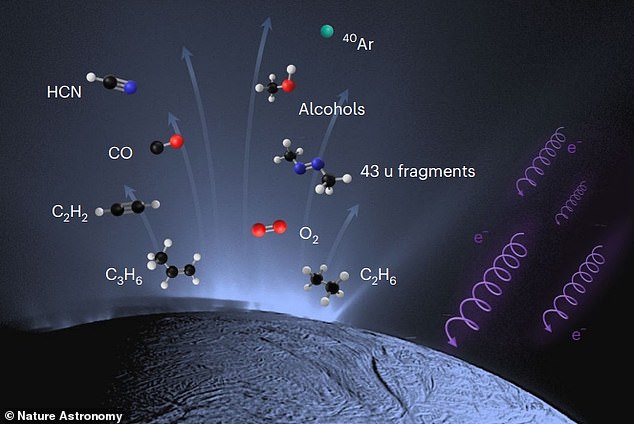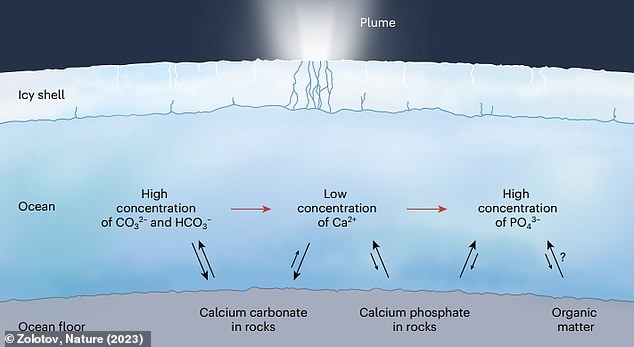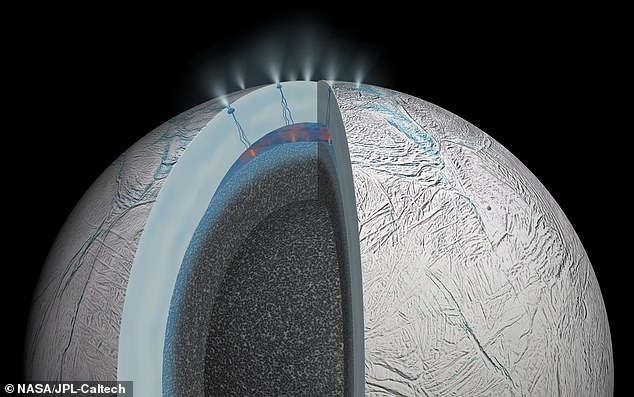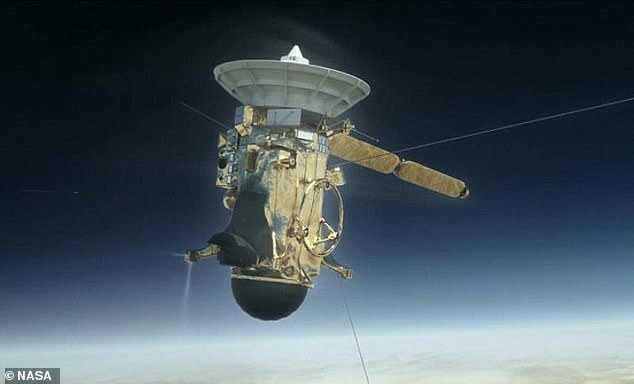Saturn’s moon could harbour ALIEN life: Scientists discover organic molecules in Enceladus’ plume that suggest it could be habitable
It is one of the most beautiful objects in our solar system, a shimmering ball of pure white ice, hiding a liquid ocean inside.
But even though it doesn't look like our planet, Enceladus, Saturn's sixth-largest moon, may have something in common with Earth: the presence of life.
Scientists have discovered organic molecules in the moon's plumes that could support “communities” of tiny microbes.
Researchers believe that these compounds can support metabolism or amino acid synthesis.
Experts already know that there are phosphate, methane, hydrogen and carbon dioxide on Enceladus' surface, all of which are possible signs of life as well.
Enceladus — Saturn's sixth largest moon — is a frozen sphere just 313 miles in diameter (about one-seventh the diameter of Earth's moon). It is depicted in this image taken by NASA's Cassini spacecraft

Plumes from Saturn's moon Enceladus contain compounds including hydrogen cyanide (HCN), acetylene (C2H2), propylene (C3H6) and ethane.
The findings are detailed in a new study conducted by Jonah Peter, a doctoral student in biophysics at Harvard University in Boston.
“Here we report the discovery of several additional compounds of great importance for the habitability of Enceladus,” say the authors.
“Our results suggest the existence of a chemically rich and diverse environment that could support complex organic synthesis and perhaps even the origin of life.”
Enceladus has an outer layer of ice at least 12 miles thick covering a liquid ocean of water inside.
Long, snake-like cracks on its icy surface spew huge plumes of ice grains and water vapor into space.
At least some of these plumes are thought to be frozen drops of a mysterious liquid ocean, perhaps an underwater abyss teeming with life forms.
Before ending its mission in 2017, NASA's Cassini spacecraft not only imaged Enceladus' plumes, but flew directly through them.
Peter and his colleagues studied data from Cassini's Neutral Ion and Mass Spectrometer (INMS), collected during flybys in 2011 and 2012.
The team used a statistical analysis technique that analyzed billions of possible combinations of column material.

Enceladus, Saturn's sixth largest moon, has an outer layer of ice covering a liquid ocean of water. Researchers have discovered the presence of phosphate in ice emitted in “plumes.” These plumes are composed of water vapor and ice grains that are believed to have come from the ocean

This image imagines a cross section of Enceladus. Note the long fractures on the ice surface that extrude the columns. These columns are composed of ice grains and water vapor
From this, they determined that the most likely composition of the plumes were the five molecules that had already been identified – water, carbon dioxide, methane, ammonia and molecular hydrogen.
The fact that the Moon is spewing methane is exciting, because this is an organic molecule that is typically produced or used by microbial life.
The presence of methane in these plumes has led scientists to hypothesize that microbes may be living, or have lived, beneath Enceladus' crust.
But the researchers also found newly identified molecules of hydrogen cyanide (HCN), acetylene (C2H2), propylene (C3H6), and ethane (C2H6), as well as traces of alcohol (methanol) and molecular oxygen.
“Such compounds could serve as direct substrates for biological growth, or be mediators for other metabolic reactions involving additional organic substances and oxidants,” the team says.
The researchers point out that the ability of these compounds to support life on Enceladus depends largely on the extent to which they are diluted in the subsurface ocean of the moon.

Cassini is pictured here in a NASA illustration. Cassini launched from Cape Canaveral, Florida, in October 1997
But the team hopes that there is a complex and diverse “hydrothermal environment” beneath the moon's icy exosphere, possibly at the bottom of the ocean.
The presence of acetylene and ethane in the column also indicates “continuous catalytic reactions” driven by metal-bearing minerals within the perimeter.
One day, experts will have made all the assumptions they can about Enceladus from the Cassini data — at which point more missions will be needed.
Determining whether life exists, or has ever existed, on Enceladus will very likely be another spacecraft's mission.
Until then, science fiction authors are sure to draw inspiration from the unique geological formation of this icy world, 313 miles away from humanity.
“More detailed examination of Enceladus's oceanic material will require future robotic missions,” the study authors concluded.
The full results have been published in Nature astronomy.
(Tags for translation)dailymail

